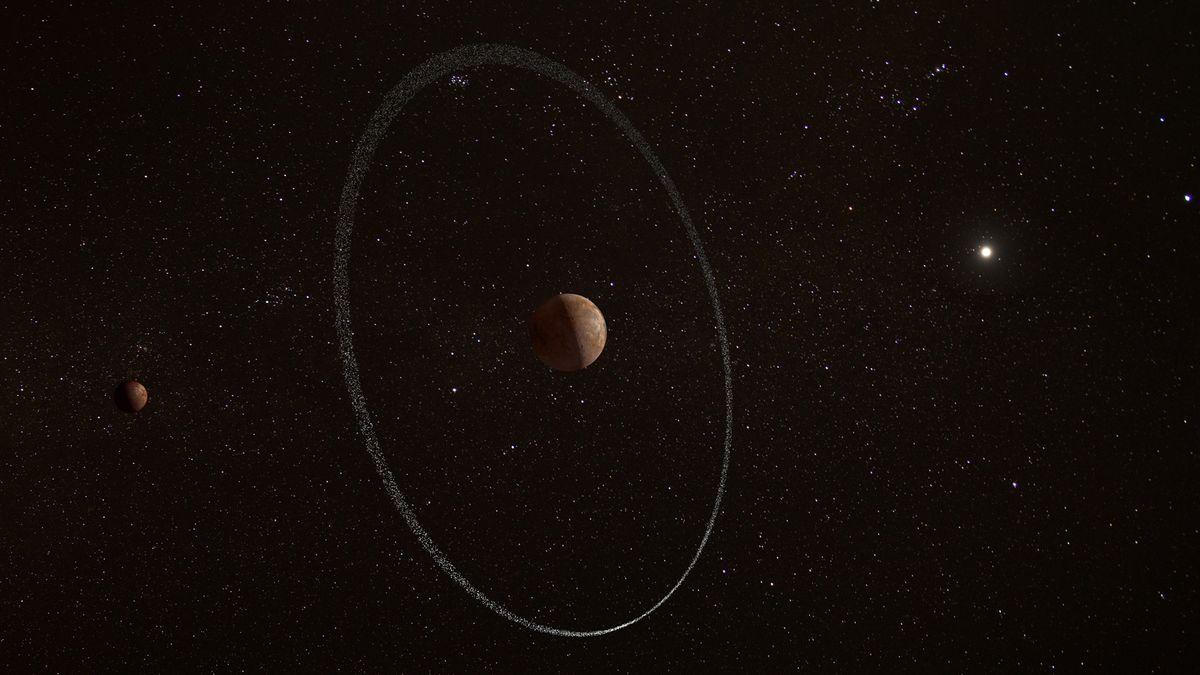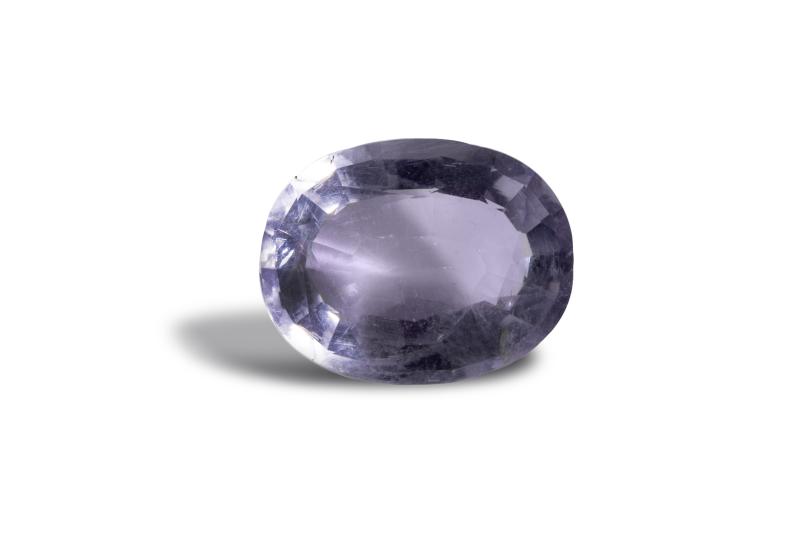
The #Submerged #City of #Krishna #DISCOVERED - #Dwarka Discover the enigmatic Lost City of Dwarka, an ancient submerged city off the coast of modern-day #Gujarat, #India. Revered in Hindu scriptures as the submerged city from the kingdom of Krishna, Dwarka's existence intertwines myth and #history. Recent underwater explorations have unearthed compelling archaeological evidence, bolstering claims of its historical reality. This legendary city, mentioned in the #Mahabharata, captivates historians and archaeologists. Its discovery offers insights into ancient Indian civilization and corroborates historical narratives. Dwarka's underwater ruins, with stone structures and artifacts, provide a fascinating glimpse into a lost Hindu civilization at the bottom of the sea of India. Explore the mystery and legacy of Dwarka, a pivotal site in India's rich history and mythology. https://www.youtube.com/watch?v=AFmn5yyVRXo
#discovered

A #mini-planet orbiting in the frigid #outer reaches of the #solarsystem has a #Saturn-like #ring of #dust and #debris that #defies the rules of #physics, a new study has #revealed.
The planet in question is called #Quaoar and it's the #seventh largest of the known #dwarf #planets of which #Pluto is the #king. #Discovered in #2002 and about 697 miles wide (1,121 kilometers), Quaoar is one of the so-called #trans-Neptunian objects, small planets orbiting #beyond the solar system's outermost planet #Neptune.
Residing in the #KuiperBelt, the doughnut-shaped ring of rocky and icy debris in the outer solar system, Quaoar is a proud owner of its own #moon, the 100-mile-wide (160 km) #Weywot. And a recent observation campaign revealed that it also has a ring of material in its orbit.
That by itself wouldn't be so special. The gas giant Saturn is known to possess a whole series of rings. #Jupiter, Neptune and #Uranus also have some. One other trans-Neptunian object — #Haumea — has been found to have a ring, and the space rock #Chariklo that orbits between #Saturn and #Uranus also has one. So what exactly sets Quaoar's ring apart?
Related: Dwarf planets: science & facts about the solar system’s smaller worlds
Quaoar's ring is at a very unusual #distance from its parent body. In fact, before astronomers discovered Quaoar's ring in observations from several telescopes conducted between 2018 and 2021, they had thought that it was impossible for a ring to exist at such a distance. With a radius of about 2,420 miles (3,885 km) from Quaoar's center, the ring is too far away from the dwarf planet that its gravity should no longer be able to keep the material dispersed. Instead, it should coalesce under its own gravity and form another moon, just like Weywot. By not having done that, the ring has breached what astronomers call the Roche limit, the first known ring around a #celestial body to have done so.
"What is so intriguing about this discovery around Quaoar is that the ring of material is much farther out than the Roche limit," Giovanni Bruno, an astronomer at Italy's National Institute for Astrophysics (INAF) and one of the authors of the paper, said in a European #Space Agency (ESA) statement. "As a result of our observations, the classical notion that dense rings survive only inside the Roche limit of a planetary body must be thoroughly revised."
The ring was discovered during a series of occultations, essentially eclipses, when Quaoar passed between Earth and several more distant but much brighter stars. When an occultation occurs, the light of the background star temporarily dims. The effect is only visible to very sensitive telescopes and is frequently used to detect exoplanets orbiting stars in our Milky Way galaxy, which is why ESA's exoplanet hunter Cheops was among the telescopes watching these Quaoar occultations.
When astronomers analyzed the data, they realized that apart from the main dip in the background stars' brightness, they could detect two smaller drops. Since drops occurred before and after the main occultation, respectively, the researchers thought that Quaoar must be surrounded with a ring.
Several Earth-based telescopes also observed the occultations with similar results, but Cheops' data were particularly valuable as they proved that the odd dimmings were not caused by the effects of Earth's atmosphere.
https://www.space.com/mysterious-ring-around-dwarf-planet-puzzles-astronomers
https://www.bitchute.com/video/4HRc1UvrdiAN/
IT Is #Now OFFICIALLY PROVEN.... There Has ALSO Been #Discovered to be An On Going EFFORT to Hide The Information... The #Internet is #Shadow-banning!!!
Longest stretch of #Ancient #Jerusalem’s upper #aqueduct #discovered

The excavations of the ancient aqueduct in Jerusalem. The upper aqueduct served the area of the city where the Jewish and Armenian Quarters are now situated.
https://www.sott.net/article/484005-Longest-stretch-of-Ancient-Jerusalems-upper-aqueduct-discovered
#Archaeologists in #France have #discovered 1,800-year-old #Gallo-Roman 3 #artifacts in a former #Roman shale #quarry that had become a trash pit. The discovery at #Rennes included two small #statues of the Roman #goddess #Venus, among other artifacts.

Roman Venus Statues Found Amongst the Garbage
“Once in a lifetime” 1300-year-old #gemstone #necklace #discovered in #England may have belonged to high status

#Discovered in #Greenland in the late 1890's, #hackmanite is named for Finnish geologist Victor Hackman. It is a rare occurrence to find gem-grade hackmanite; at best, most crystals are translucent. Hackmanite is the light pink to pale violet variety of sodalite. It is a particularly unusual gem because it exhibits a special optical property known as "tenebrescence," a type of reversible photochromism. This feature allows the gems to temporarily change color when exposed to different light forms. While hackmanite gems are usually pink to violet, the color quickly fades to gray or greenish-white in sunlight, and will slowly return to the original color after changing the light. Its tenebrescent property makes hackmanite a prized mineral for collectors.
Countries of Origin
Canada; Myanmar; Afghanistan; Russian Federation; Unknown; Guinea; Norway; United States of America; Greenland
Care
When exposed to sunlight the color will fade to white. Color will return if stones are stored in darkness for several days or when exposed to shortwave ultraviolet light.
Beautiful New Species of Jellyfish Photographed 2,300 Feet Under the Sea
![]()
![]()
As part of a 2021 North Atlantic Stepping Stones expedition, what is called a potentially "unknown" or "undescribed" red jellyfish in the genus Poralia was captured on camera. The disk-shaped red jellyfish was found floating nearly 2,300 feet below the surface.
An "undescribed" species is the term scientists use to classify a creature that has never received a specific name in a formal scientific publication and is, therefore, previously unknown to scientists.
Quinn Girasek, an intern and National Oceanic and Atmospheric Administration (NOAA) Hollings Scholar with the NOAA Ocean Exploration organization describes the find as part of her role annotating the water column dive that took place in late July.
"As a Hollings intern, I am conducting research to further our understanding of previously unexplored ocean habitats," she explains. "My project this summer focuses on the abundance of organisms within the mesopelagic, or twilight zone (200 to 1,000 meters/ 656 to 3,281 feet depth) in the Atlantic Ocean around the Gulf Stream and within the deep scattering layer."
The red jellyfish is one of the species that Girasek cataloged as part of her research. This beautiful red creature in the genus Poralia is described as one that may be a previously unknown species and was seen during the third transect of Dive 20 of the 2021 North Atlantic Stepping Stones expedition, at a depth of 700 meters (2,297 feet).
<https://petapixel.com/assets/uploads/2021/08/ex2104-dive20-redjelly-640x360-1.mp4>
"Overall, a variety of animals were seen, like ctenophores, cnidarians, crustaceans, and Actinopterygii (ray-finned fishes). We also saw several undescribed families and potential new species," she continues.
In the image below, the remotely operated vehicle (ROV) Deep Discoverer is shown collecting the potentially new species of jellyfish, which also gives a sense of scale to the creature. For reference, the ROV is 10 feet long, 6.5 feet wide, and 8.5 feet tall.
![]() A total of four samples were collected during Dive 20 of the 2021 North Atlantic Stepping Stones expedition using the suction sample on remotely operated vehicle (ROV) Deep Discoverer. Here, Global Foundation for Ocean Exploration ROV pilots deftly maneuver to collect a potential new species of jellyfish during the 1200-meter (3,937-foot) dive transect.
A total of four samples were collected during Dive 20 of the 2021 North Atlantic Stepping Stones expedition using the suction sample on remotely operated vehicle (ROV) Deep Discoverer. Here, Global Foundation for Ocean Exploration ROV pilots deftly maneuver to collect a potential new species of jellyfish during the 1200-meter (3,937-foot) dive transect.
Deep Discoverer is capable of diving to a depth of 3.7 miles (6,000 meters) and can capture high-definition video and uses a set of 20 LED lights to fire 150,000 lumens of light into the darkness of the ocean's depths.
The final dive of the 2021 North Atlantic Stepping Stones expedition was dedicated to the exploration of the water column within Hydrographer Canyon through two series of transects. The first series involved transects at depths of 300, 500, 700, and 900 meters (984, 1,640, 2,297, and 2,953 feet) and the second series started with a transect within the bathypelagic or midnight zone of the ocean at 1,200 meters (3,937 feet) depth and was followed by a transect at a depth of 630 meters (2,067 feet), within the area’s "deep scattering layer" (DSL). The DSL is a region in the water column where there is such a high density of marine organisms that they generate their own sonar signal.
The "deep scattering layer" is a term used by those using active acoustics in the open ocean as a phenomenon that occurs between about 400 and 600 meters (1,312 to 1,969 feet) depth in our geographic region of study. As described by NOAA Hollings Undergraduate Scholar Herbert Leavitt, typically this layer is seen when the sound waves come into contact with a high density of mesopelagic fish or other organisms that live at depth during the day and migrate towards the surface at night to feed.
Many other creatures were observed during the expedition, and while the red jellyfish is the only one that is called out as "undescribed" or undiscovered, there are a host of others that can be seen in detail in images and video from the NOAA.
_Image and video credits: Video and images courtesy of NOAA Ocean Exploration, 2021 North Atlantic Stepping Stones: New England and Corner Rise Seamounts. _
#features #news #atlanticocean #deep #deepsea #discovered #dive #gulfstream #jellyfish #nationaloceanicandatmosphericadministration #newdiscovery #newspecies #noaa #ocean


